
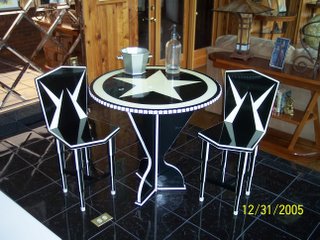
 Great Furniture In The MoviesIt might help in reading this if you're a Laurel and Hardy fan --- make that a hardcore Laurel and Hardy fan, because when you've reached the point where you're discussing the furniture in their comedies, you are indeed hardcore, maybe borderline needing help. Well, I'm that way about the Blotto table. You know (at least those of you who share my obsession know) there's that long sequence at the Rainbow Club. It's a deco speakeasy palace, and Laurel and Hardy get drunk, or they think they're getting drunk, only Stan's wife has replaced the contents of his smuggled-in bottle with brackish cold tea. Comedy mayhem ensues. So there is the story, and now we come to the table, and it is a wow --- a creampuff --- a lulu. I've wanted something like it ever since I saw the short for the first time at the age of 14. The picture in the center is from Blotto, and that's the table. Note the star, the little indentations that run around the circumference. You won't find this item at the local Transit-Damaged Freight Warehouse. Now those of you who haven't said who cares and signed off by now are probably asking, "That's all well and good, but did this unique specimen of woodwork ever make its way into any other movies?". Well, as a matter of fact it did, at least the photo at the left convinces me that it did. Do you suppose Lew Ayres called Hal Roach and said, "Hal ...Lew... Buddy, I just caught that new rib-tickling Laurel and Hardy laff-riot of yours, and I've just got to use that bitchin' nightclub table in my next picture!". And indeed, there it is, sharing a scene with Lew Ayres in Okay, America, presumably the table's first appearance in a dramatic vehicle. Isn't it great when some obscure nugget of film history reveals itself? But that isn't all, because like Lew, I was so caught up with that bitchin' table that I decided to see if maybe it could be recreated --- and that's the photo on the right. As you can see, the guy who built it is a genius, and boy, are those chairs uncomfortable. Authentic, yes, right down to the last detail, but hell to sit in. Laurel and Hardy must have wanted that prohibition hooch mighty bad to sit in those chairs. Check out the ice bucket. Henry Trivette made that too. Henry is the genius I mentioned earlier. He could make your living room look like a set from Our Dancing Daughters if you asked him to. I was even able to pass off the Blotto table as the real thing to some visiting Laurel and Hardy fans --- told 'em I bought it at the Hal Roach auction back in 1963. When I fessed up later, they were still amazed. We have some fabulous furniture makers in the South.
Great Furniture In The MoviesIt might help in reading this if you're a Laurel and Hardy fan --- make that a hardcore Laurel and Hardy fan, because when you've reached the point where you're discussing the furniture in their comedies, you are indeed hardcore, maybe borderline needing help. Well, I'm that way about the Blotto table. You know (at least those of you who share my obsession know) there's that long sequence at the Rainbow Club. It's a deco speakeasy palace, and Laurel and Hardy get drunk, or they think they're getting drunk, only Stan's wife has replaced the contents of his smuggled-in bottle with brackish cold tea. Comedy mayhem ensues. So there is the story, and now we come to the table, and it is a wow --- a creampuff --- a lulu. I've wanted something like it ever since I saw the short for the first time at the age of 14. The picture in the center is from Blotto, and that's the table. Note the star, the little indentations that run around the circumference. You won't find this item at the local Transit-Damaged Freight Warehouse. Now those of you who haven't said who cares and signed off by now are probably asking, "That's all well and good, but did this unique specimen of woodwork ever make its way into any other movies?". Well, as a matter of fact it did, at least the photo at the left convinces me that it did. Do you suppose Lew Ayres called Hal Roach and said, "Hal ...Lew... Buddy, I just caught that new rib-tickling Laurel and Hardy laff-riot of yours, and I've just got to use that bitchin' nightclub table in my next picture!". And indeed, there it is, sharing a scene with Lew Ayres in Okay, America, presumably the table's first appearance in a dramatic vehicle. Isn't it great when some obscure nugget of film history reveals itself? But that isn't all, because like Lew, I was so caught up with that bitchin' table that I decided to see if maybe it could be recreated --- and that's the photo on the right. As you can see, the guy who built it is a genius, and boy, are those chairs uncomfortable. Authentic, yes, right down to the last detail, but hell to sit in. Laurel and Hardy must have wanted that prohibition hooch mighty bad to sit in those chairs. Check out the ice bucket. Henry Trivette made that too. Henry is the genius I mentioned earlier. He could make your living room look like a set from Our Dancing Daughters if you asked him to. I was even able to pass off the Blotto table as the real thing to some visiting Laurel and Hardy fans --- told 'em I bought it at the Hal Roach auction back in 1963. When I fessed up later, they were still amazed. We have some fabulous furniture makers in the South.
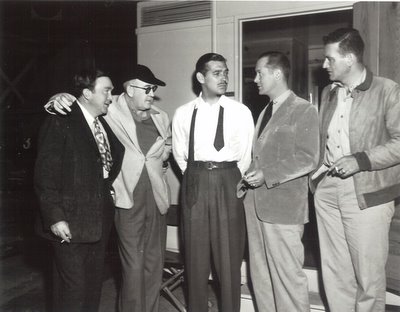 Dramatic Still Alert --- John Wayne In A Very Uncomfortable PositionSo, here's the official studio caption from the back of the still: "VETERANS ON THE SET .... Clark Gable, back in his first screen role following release from the army, visited by other veterans from the "They Were Expendable" set at Metro-Goldwyn-Mayer. Left to right are Thomas Mitchell, Commander John Ford, Gable, Lieutenant Commander Robert Montgomery, and Ward Bond."
Dramatic Still Alert --- John Wayne In A Very Uncomfortable PositionSo, here's the official studio caption from the back of the still: "VETERANS ON THE SET .... Clark Gable, back in his first screen role following release from the army, visited by other veterans from the "They Were Expendable" set at Metro-Goldwyn-Mayer. Left to right are Thomas Mitchell, Commander John Ford, Gable, Lieutenant Commander Robert Montgomery, and Ward Bond."
That's the set of Adventure by the way, and the guy on the right sure as hell ain't Ward Bond. And he ain't no veteran either (neither is Tommy Mitchell, but he's kinda old, and besides, he got hurt pretty bad that time he fell off the horse trying to catch those carpetbagging Yankees). Well, just imagine how John Wayne felt when the old man suggested they walk over to the adjoining stage and visit Major Gable. I bet Ford, I mean Commander Ford, made Duke go, just for the hell of putting him on the griddle for not having served. We've read those stories about how the director humiliated Wayne in front of cast and crew during They Were Expendable ("For God's sake, Duke, can't you at least salute as if you'd been in the service?"). John Wayne looks really akward in this still --- standing behind Lt. Commander Montgomery, and like, totally shut out of the bull session. You can see where Ford's brought Mitchell into the circle, because, well, he couldn't help falling off that horse, could he? Anyway, what do you suppose these guys were saying? My guess is, Ford told some colorful anecdote about that time on Midway when the enemy shot the 16mm camera out of his hand. Gable probably recalled the day he was nearly shot down during that bombing mission over Germany, and Montgomery no doubt regaled the guys with some of the close calls he had aboard those speedy little PT boats. So, what does Duke say? Nothing, if he's smart, and I've always read that Wayne was a pretty bright guy. I mean, what if he had interrupted with some lame story of how he nearly fell off a tractor last year while they were shooting The Fighting Seebees? Can't you picture Montgomery turning around and just looking at him? I'll bet Ford made fun of Duke right when they shot this picture. He could be a cruel guy. Yeah, I've read about how he could be a cruel guy. But he still made great movies. All these fellows did. There's a lot of hindsight drama to be mined from these old set candids, and we hope to be delving into a lot more of them in months to come here at the Greenbriar.
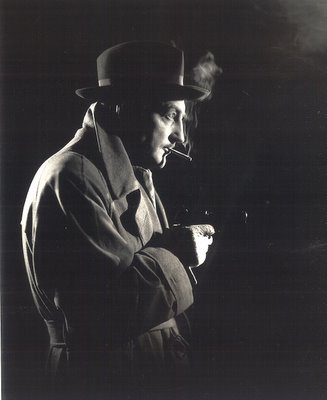
 Mr. and Mrs. Warren William At HomeThe date on back of the still says October 17, 1935, so I guess it's one of those "just plain folks at home" sittings that Warner Bros., and everyone else, was doing in an effort to make their stars more agreeable identification figures. After a dose of Employee's Entrance, The Mind Reader, and/or Skyscraper Souls, it might have been hard for anyone to buy Warren William as a simple family man, but hey, that's what great acting is all about. I could sure get into some of that lemon pie they're eating, by the way. It looks great. For purposes of proper balance, we would like to present another pose far more typical of the Warren we know and love so well (it's from Columbia's The Lone Wolf Meets A Lady).
Mr. and Mrs. Warren William At HomeThe date on back of the still says October 17, 1935, so I guess it's one of those "just plain folks at home" sittings that Warner Bros., and everyone else, was doing in an effort to make their stars more agreeable identification figures. After a dose of Employee's Entrance, The Mind Reader, and/or Skyscraper Souls, it might have been hard for anyone to buy Warren William as a simple family man, but hey, that's what great acting is all about. I could sure get into some of that lemon pie they're eating, by the way. It looks great. For purposes of proper balance, we would like to present another pose far more typical of the Warren we know and love so well (it's from Columbia's The Lone Wolf Meets A Lady).

 American-International Stages A PremiereColonel Roy Forehand was the manager of our local Liberty Theatre when I was growing up, and every three or so months, I would venture up to his office where an accumulation of movie pressbooks would be waiting. He'd been passing them along to me since the beginning of school year in 1964, and I happily recall that crisp September day when I came home to find the Black Sabbath and Masque Of The Red Death campaign manuals lying on my bedspread (a gift from Mr. Forehand via my father). From that moment, I was hooked on pressbooks (still am!). By the Summer of 1965, I was a seasoned collector, and that's when Tomb Of Ligeia was scheduled to play the Liberty. My personal crisis arose when Mr. Forehand booked the feature as a "Late Show" on a Saturday night --- 9:30 p.m. only. My heart sank when I saw the modest newspaper ad. There was no way my parents would allow me to attend a movie at such an hour, and those "Late Shows" had a frightening reputation among schoolmates (and their parents). I was told of children who had entered the Liberty for a 9:30 movie, and were never seen again. The boy's bathroom could be a frightful place on a Saturday night --- those monsters with their cigarettes and steel-tipped boots you could see under the door from the stairs were far more terrifying than anything on the screen in the auditorium. To walk into that bathroom was to enter the jaws of something worse than death, and yet --- I just had to see Tomb Of Ligeia! My pleas that week to Mr. Forehand were at first met with indifference. He was all set for a 9:30 show, and that was that. As days went by, I was increasingly desperate. After all, had I not previously missed The Last Man On Earth, Devil Doll, and The Unearthly Stranger because they too, were "Late Shows Only"? Finally, within days --- no, within agonizing hours of the appointed playdate, he relented and agreed to an "all-day" booking. NOW --- How does all this digression relate to the image at right? Well, this little flyer was inserted into the pressbook which was given me by the self-same Col. Forehand back in 1965 when Tomb Of Ligeia was brand new, and I've never seen it turn up anywhere else. That's why I'm posting it here, plus the fact that it displays quite a bizarre combination of personalities for that long-ago premiere. Just highlight the image and check out the fotos. That "hunchback" participant, unless I'm wrong, appears to be wearing a Don Post mask, and yes, that's Carroll Borland (her name's misspelled in the blurb) appearing in character as the vampire woman, over 30 years after her supporting role in Mark Of The Vampire. Maila Nurmi (name also misspelled!), maintaining her dignity, is clad in more or less straight attire. I wonder if Carroll got around to confronting Maila about the "Vampira" image that the latter had more or less filched from the former for the well-remembered 50's late night horror show. As for Elsa Lanchester, was she there at the behest, or insistence, of AIP execs? Having recently finished Pajama Party for the company, perhaps she was hopeful of further employment. Vincent Price, as we all know, was a good sport, and always willing to enter into the spirit of such folderal for the sake of publicity, and although he's not visible in any of these shots, I strongly suspect the background presence of Forey Ackerman amidst the throng. Maybe he brought along that mask for the erstwhile Hunchback.
American-International Stages A PremiereColonel Roy Forehand was the manager of our local Liberty Theatre when I was growing up, and every three or so months, I would venture up to his office where an accumulation of movie pressbooks would be waiting. He'd been passing them along to me since the beginning of school year in 1964, and I happily recall that crisp September day when I came home to find the Black Sabbath and Masque Of The Red Death campaign manuals lying on my bedspread (a gift from Mr. Forehand via my father). From that moment, I was hooked on pressbooks (still am!). By the Summer of 1965, I was a seasoned collector, and that's when Tomb Of Ligeia was scheduled to play the Liberty. My personal crisis arose when Mr. Forehand booked the feature as a "Late Show" on a Saturday night --- 9:30 p.m. only. My heart sank when I saw the modest newspaper ad. There was no way my parents would allow me to attend a movie at such an hour, and those "Late Shows" had a frightening reputation among schoolmates (and their parents). I was told of children who had entered the Liberty for a 9:30 movie, and were never seen again. The boy's bathroom could be a frightful place on a Saturday night --- those monsters with their cigarettes and steel-tipped boots you could see under the door from the stairs were far more terrifying than anything on the screen in the auditorium. To walk into that bathroom was to enter the jaws of something worse than death, and yet --- I just had to see Tomb Of Ligeia! My pleas that week to Mr. Forehand were at first met with indifference. He was all set for a 9:30 show, and that was that. As days went by, I was increasingly desperate. After all, had I not previously missed The Last Man On Earth, Devil Doll, and The Unearthly Stranger because they too, were "Late Shows Only"? Finally, within days --- no, within agonizing hours of the appointed playdate, he relented and agreed to an "all-day" booking. NOW --- How does all this digression relate to the image at right? Well, this little flyer was inserted into the pressbook which was given me by the self-same Col. Forehand back in 1965 when Tomb Of Ligeia was brand new, and I've never seen it turn up anywhere else. That's why I'm posting it here, plus the fact that it displays quite a bizarre combination of personalities for that long-ago premiere. Just highlight the image and check out the fotos. That "hunchback" participant, unless I'm wrong, appears to be wearing a Don Post mask, and yes, that's Carroll Borland (her name's misspelled in the blurb) appearing in character as the vampire woman, over 30 years after her supporting role in Mark Of The Vampire. Maila Nurmi (name also misspelled!), maintaining her dignity, is clad in more or less straight attire. I wonder if Carroll got around to confronting Maila about the "Vampira" image that the latter had more or less filched from the former for the well-remembered 50's late night horror show. As for Elsa Lanchester, was she there at the behest, or insistence, of AIP execs? Having recently finished Pajama Party for the company, perhaps she was hopeful of further employment. Vincent Price, as we all know, was a good sport, and always willing to enter into the spirit of such folderal for the sake of publicity, and although he's not visible in any of these shots, I strongly suspect the background presence of Forey Ackerman amidst the throng. Maybe he brought along that mask for the erstwhile Hunchback.
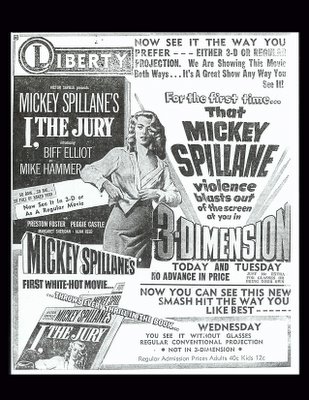 A 3-D Surprise (At Least For Me)Here's an October, 1953 ad from the small-town theater where I grew up, although 1953 pre-dates me by a few months. Anyway, I'm digging through the microfilm at our local Community College, checking out those first engagements of 3-D in our small town, and this ad jumped out at me (like a lion in my lap!). I mean, whoever heard of a feature being shown both ways during a single engagement? Maybe such things were commonplace, and I just never heard (or read) about them. Our beloved Liberty Theatre was owned and operated at that time by a great showman named Ivan Anderson (with son-in-law Colonel Roy Forehand), who'd started out in vaudeville and was heavily involved in the promotion and exploitation of 3-D for the Southeast region (how do I know this? --- he was featured in Boxoffice several times during 1953). We all know that 3-D was a flash in the pan, and by October of '53, I suspect Ivan knew it too. His willingness to offer I, The Jury both ways may well have been a response to patron requests. So many 3-D presentations were hampered by a myriad of technical problems, and those glasses had to be a drag (plus, they weren't free!). By the Autumn of that year, the novelty had definitely worn off, even in a small town like ours. When I finally had the opportunity to search all the storage rooms and closets at the Liberty, around 1975, I found boxes of unused 3-D glasses, mute testimony of a fascinating period of film history that had come and gone.
A 3-D Surprise (At Least For Me)Here's an October, 1953 ad from the small-town theater where I grew up, although 1953 pre-dates me by a few months. Anyway, I'm digging through the microfilm at our local Community College, checking out those first engagements of 3-D in our small town, and this ad jumped out at me (like a lion in my lap!). I mean, whoever heard of a feature being shown both ways during a single engagement? Maybe such things were commonplace, and I just never heard (or read) about them. Our beloved Liberty Theatre was owned and operated at that time by a great showman named Ivan Anderson (with son-in-law Colonel Roy Forehand), who'd started out in vaudeville and was heavily involved in the promotion and exploitation of 3-D for the Southeast region (how do I know this? --- he was featured in Boxoffice several times during 1953). We all know that 3-D was a flash in the pan, and by October of '53, I suspect Ivan knew it too. His willingness to offer I, The Jury both ways may well have been a response to patron requests. So many 3-D presentations were hampered by a myriad of technical problems, and those glasses had to be a drag (plus, they weren't free!). By the Autumn of that year, the novelty had definitely worn off, even in a small town like ours. When I finally had the opportunity to search all the storage rooms and closets at the Liberty, around 1975, I found boxes of unused 3-D glasses, mute testimony of a fascinating period of film history that had come and gone.
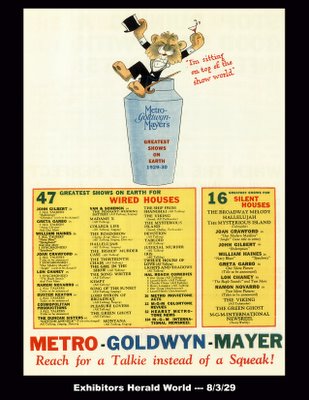
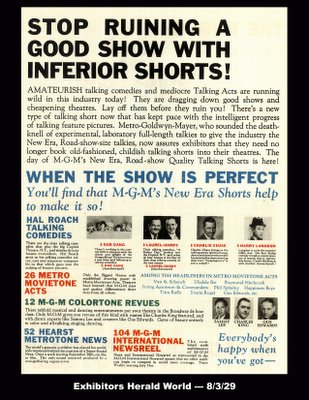 MGM At The Dawn Of SoundYou might want to highlight and enlarge the above trade ads, because the small print yields some fascinating insight into Metro's sale strategies during that first turbulant year of sound production. These promotions were designed to herald the coming 1929-30 release season, and the feature page clearly illustrates the battle lines now drawn between "wired" and still-silent houses. Exhibitors who couldn't afford the very expensive sound equipment were exerting a lot of pressure for the studios to continue providing silent product. The compromise was to offer silent versions of talking pictures, a generally unsatisfactory solution that left audiences feeling cheated. Metro still had a number of important silent attractions opening throughout 1929 --- Desert Nights, Our Modern Maidens, Speedway --- and each of these were available with synchronized music/effects scores on disc. Their final silent feature would be The Kiss, released November 2, 1929. As for those silent versions of talking pictures, one can only imagine the frustration of watching The Broadway Melody in such a presentation, yet many audiences did, and I'd venture to say that MOST small-town and rural patrons saw the groundbreaking musical sans music. Many exhibitors complained that the so-called "silent" versions were merely the same prints used for the talkie presentations, minus the discs. With no intertitles, and of course no sound, you can imagine the confusion that would attend any screening of such hybrids.
MGM At The Dawn Of SoundYou might want to highlight and enlarge the above trade ads, because the small print yields some fascinating insight into Metro's sale strategies during that first turbulant year of sound production. These promotions were designed to herald the coming 1929-30 release season, and the feature page clearly illustrates the battle lines now drawn between "wired" and still-silent houses. Exhibitors who couldn't afford the very expensive sound equipment were exerting a lot of pressure for the studios to continue providing silent product. The compromise was to offer silent versions of talking pictures, a generally unsatisfactory solution that left audiences feeling cheated. Metro still had a number of important silent attractions opening throughout 1929 --- Desert Nights, Our Modern Maidens, Speedway --- and each of these were available with synchronized music/effects scores on disc. Their final silent feature would be The Kiss, released November 2, 1929. As for those silent versions of talking pictures, one can only imagine the frustration of watching The Broadway Melody in such a presentation, yet many audiences did, and I'd venture to say that MOST small-town and rural patrons saw the groundbreaking musical sans music. Many exhibitors complained that the so-called "silent" versions were merely the same prints used for the talkie presentations, minus the discs. With no intertitles, and of course no sound, you can imagine the confusion that would attend any screening of such hybrids.

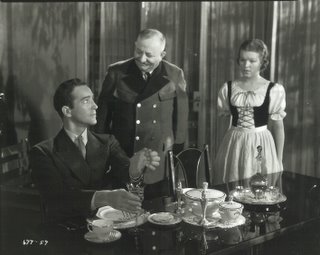 David Manners Is "Breakfasting" In The Black CatHere's a still I haven't seen before from The Black Cat, although the scene is referenced by Karloff when asked of Manner's whereabouts at one point in the film. Considering that the feature was released at only 64 minutes, you wonder how many such moments were shot, and eventually deleted, from the final print. The Black Cat was one of the first features I ever owned as a 16mm collector, having purchased it in 1973 from a then-friend in Pennsylvania for the princely sum of $125 (haven't heard from Alan in twenty-five odd years --- hope he's well). This was a "dupe", of course, but in those days, it was a truly extraordinary thing to actually possess a print of a favorite movie, and to be able to show it whenever and whereever you pleased. I used to carry those two plastic 1200' reels into a lot of odd places --- for instance setting up the Bell&Howell projector on the information desk at Lenoir-Rhyne College during the night and running The Black Cat when I was supposed to be answering the switchboard --- or playing it outdoors one memorable Summer night on the banks of Lake Norman, along with Chapter 1 of Flash Gordon Conquers The Universe. In 1974, I ran it on campus as part of a double-bill with my bootlegged 16mm print of Red Dust, using stills I'd ordered from the old "Memory Shop" in NYC for publicity. All told, I must have screened that print of The Black Cat at least twenty or thirty times during that first year or two of excited ownership. I've now been in possession of Universal's DVD of The Black Cat since October and have screened it not once. There's a differance between owning four 16mm features in 1973 and having hundreds of DVD's in 2005. I wouldn't want to go back to the way it was, but I also realize that, as a "collector" of DVD as opposed to 16mm, the thrill is gone. Acquiring The Black Cat as a neat, Universal-shrinkwrapped Wal-Mart product is not the same as hoarding a rare, unattainable, possibly black market 16mm print. Now that's a distinction.
David Manners Is "Breakfasting" In The Black CatHere's a still I haven't seen before from The Black Cat, although the scene is referenced by Karloff when asked of Manner's whereabouts at one point in the film. Considering that the feature was released at only 64 minutes, you wonder how many such moments were shot, and eventually deleted, from the final print. The Black Cat was one of the first features I ever owned as a 16mm collector, having purchased it in 1973 from a then-friend in Pennsylvania for the princely sum of $125 (haven't heard from Alan in twenty-five odd years --- hope he's well). This was a "dupe", of course, but in those days, it was a truly extraordinary thing to actually possess a print of a favorite movie, and to be able to show it whenever and whereever you pleased. I used to carry those two plastic 1200' reels into a lot of odd places --- for instance setting up the Bell&Howell projector on the information desk at Lenoir-Rhyne College during the night and running The Black Cat when I was supposed to be answering the switchboard --- or playing it outdoors one memorable Summer night on the banks of Lake Norman, along with Chapter 1 of Flash Gordon Conquers The Universe. In 1974, I ran it on campus as part of a double-bill with my bootlegged 16mm print of Red Dust, using stills I'd ordered from the old "Memory Shop" in NYC for publicity. All told, I must have screened that print of The Black Cat at least twenty or thirty times during that first year or two of excited ownership. I've now been in possession of Universal's DVD of The Black Cat since October and have screened it not once. There's a differance between owning four 16mm features in 1973 and having hundreds of DVD's in 2005. I wouldn't want to go back to the way it was, but I also realize that, as a "collector" of DVD as opposed to 16mm, the thrill is gone. Acquiring The Black Cat as a neat, Universal-shrinkwrapped Wal-Mart product is not the same as hoarding a rare, unattainable, possibly black market 16mm print. Now that's a distinction.












